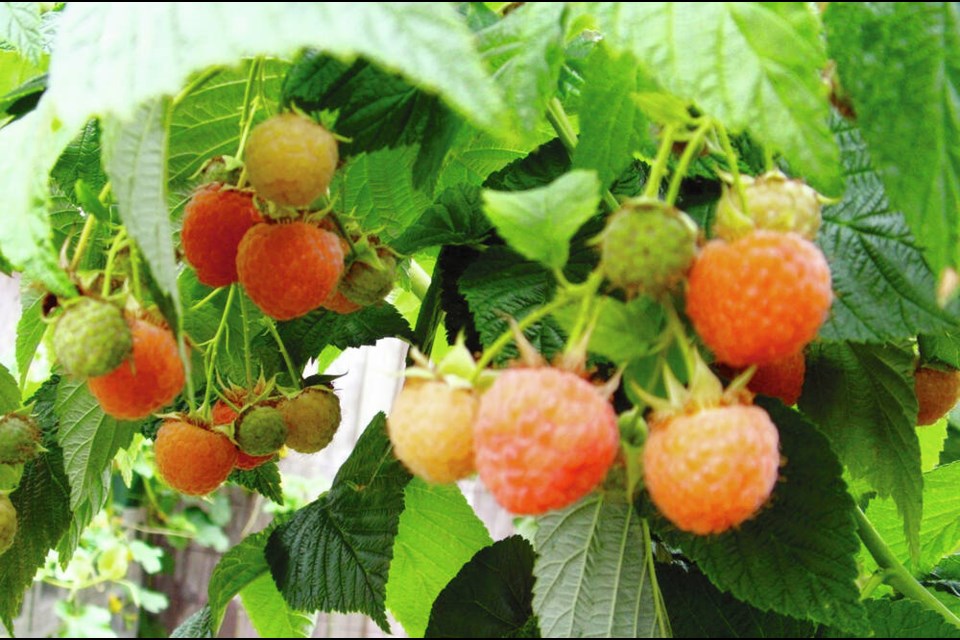Dear Helen: I’ve been placed in charge of the raspberries in the courtyard food garden of my apartment complex. All I know about them is that last summer they produced an early to midsummer crop of berries and then another one in late summer. I see they are leafing out now. I need to know how to manage them. When and how are they pruned?
C.D.
Yours is one of the questions I’m asked most often. First, it is helpful to be aware of the two types of raspberries.
“Summer bearing” raspberries have one harvest season, in July. The berries are borne on canes that developed in the previous year. Canes that have finished producing berries are cut down to allow the new canes that will bear the next year’s crop to develop well.
“Everbearing” raspberries give an early summer crop and another in late summer to early autumn. You have this kind. The late crop is borne along the tips of canes produced in the current year. When that crop is over, those upper cane sections are cut away and the canes are left to bear the following year’s early summer crop of berries. Then they are cut down at ground level, leaving new canes to grow and produce the late crop.
Common advice, for the sake of simplicity in managing the planting, is to cut down all the everbearing canes at winter’s end. That eliminates the early summer berries. New canes that grow in the spring will give only the one, late season crop.
I don’t do that, because I prize the early summer berries and the late season crop often coincides with early autumn rains that turn the berries mouldy. Once you get into the routine of cutting away the dried upper cane portions after the late crop and cutting down those same canes after they give the next year’s early crop, managing the planting is fairly simple.
Check the canes. If there remain any withered upper portions, where the late crop berries were last year, cut them away now. Make the cuts right above the uppermost, healthy looking green shoot.
If the canes are crowded, thin out the weakest. Optimum air circulation and exposure to sunlight in the planting will help to guarantee robust growth and fine, sweet berries.
Dear Helen: For the past two years I’ve been unable to find the potting soil that I’d used for years in my indoor seeding mixtures. My tomato seedings have failed in both years. Have you had any similar issues? What mixtures have worked best for you?
A.B.
Significant changes to potting soil mixtures available in the past two years have caused difficulties to many home gardeners. My own longtime reliable products have disappeared, and it has been a scramble to find substitutes that work. Last year I had germination failures that I’d never experienced before.
So far this year, I’ve had excellent germination of the seeds I’ve sown indoors, using a mix I blend myself from different products. Because the nine-cm deep flats I use for seeding house the seeds through the seedling stage to transplant size, I use a mix that approximates a potting mix.
I begin with Pro-Mix HP. I actually prefer Pro-Mix BX, the “basic” mix, but it is not available in outlets near me. HP stands for high porosity, meaning it has a lower level of moisture retention because of the perlite content.
I start with Pro-Mix and add approximately a third as much of either Island Finest Ultimate Organic Potting mix, suitable for all indoor and outdoor use, or Cinnebar Valley Premium Organic All-Purpose potting mix.
Since products seem to be continually changing, I expect that the next time I need to purchase a potting mix I may not find what I’ve become used to. A safeguard is to check carefully for the “all-purpose” designation. That means that the mix is suitable for both indoor seeding and outdoor potting. Directions for sowing seeds on the bag is another assurance of the all-purpose nature of the mix.
Then, buy one bag to check the texture is to your liking. Some mixes are light and peaty. Others are heavier and more soil-like.
Depending on the product I can find, and taking into account the very light, porous nature of the Pro-Mix HP. I may add vermiculite for added moisture retention.



